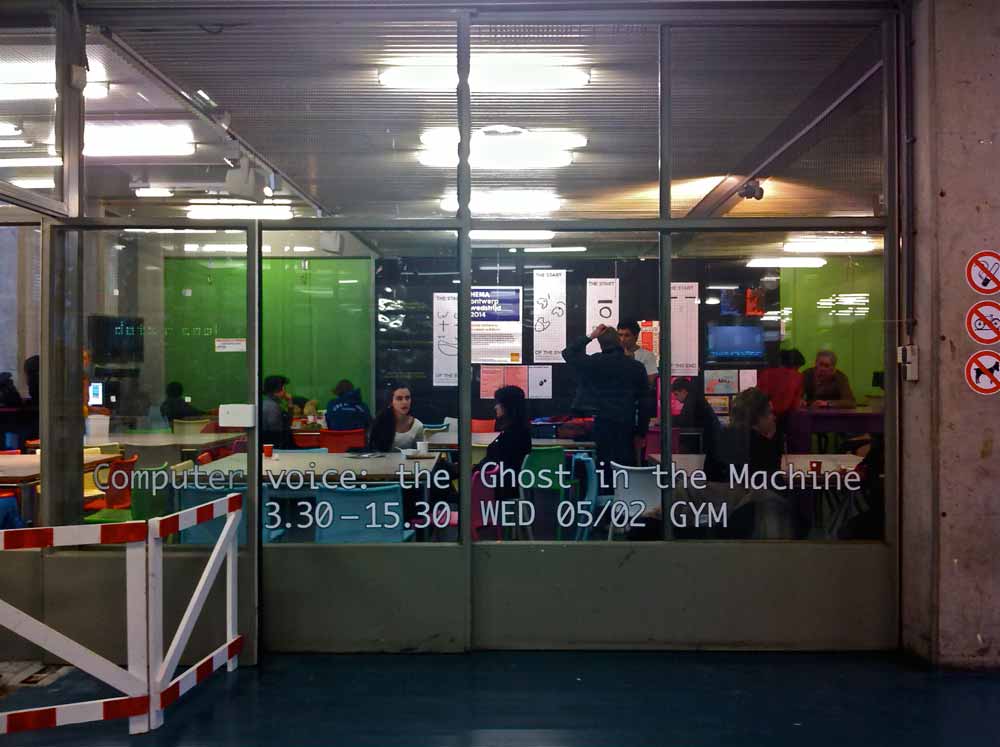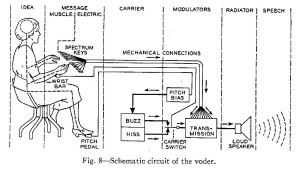 Arthur Dirksen creator of synthetic voices, will talk about the techniques involved in the creation of synthetic voices. From vintage formant-based synthesis, through diphone synthesis, to the unit selection techniques that are predominant today, we will see that naturalness increases as we rely more on recordings of actual human speech.
Arthur Dirksen creator of synthetic voices, will talk about the techniques involved in the creation of synthetic voices. From vintage formant-based synthesis, through diphone synthesis, to the unit selection techniques that are predominant today, we will see that naturalness increases as we rely more on recordings of actual human speech.Andre Castro, voice artist, presents a performance where a chat-bot gains a more human face through the translation of her textual output into vocal utterances. But her human condition isn’t entirely satisfying, therefore she wants to remain partly machine?–?to be perfect, to have a voice without a body, and most importantly; to sing in key. These desires bring her voice into a world of sound manipulation, algorithms and effects.
Aaron Schuster: The Acousmatic Voice
According to psychoanalysis, the voice is a strange kind of object, situated on the border between inside and outside, self and other, meaning and enjoyment. It both belongs to the body, emanating from its interior and carrying with it the self’s innermost thoughts and emotions, and yet is also unplaceable and uncontrollable, a foreign element that dispossesses the subject of its identity.
In this short presentation, we will focus on the phenomenon of the acousmatic voice. The term is taken from musicology (Pierre Schaeffer) and cinema studies (Michel Chion), where it designates a voice whose source cannot be seen or immediately located. This raises the question: can the origin of voice ever be precisely determined?
PLUS
Launch of the new masterclass Circuit Bending the Voice, news from Rietveld Uncut, a Beam Club sneak preview and performances by A Voice and Nothing More? (reading group lead by Clare Butcher) and Let’s Voice! Let’s Vote! (masterclass performance poetry by Quinsy Gario)
GUEST SPEAKERS / PERFORMERS
Aaron Schuster is a philosopher and writer. He teaches the Theory program at the Sandberg Institute, and is a fellow at the Institute for Cultural Inquiry ICI Berlin. He has written on such topics as the philosophy of tickling, sneezing and cinema, the history of levitation, the films of Ernst Lubitsch, anti-sexuality, complaining, and the politics of laziness, and has collaborated as a writer with artists on a number of projects. His book The Trouble with Pleasure: Deleuze and Psychoanalysis is forthcoming with MIT Press.
Martine Neddam is an artist who uses language as raw material. Her favourite subjects have always been “speech acts”, modes of address, words in the public space. Since 1996 she became an internet art pioneer, creating virtual characters who lead an autonomous artistic existence in which the real author is invisible. One of them became a cult figure of identity creation: Mouchette and her website mouchette.org.
Arthur Dirksen studied Dutch language and literature at the University of Utrecht with a major in Linguistics. After his PhD he became involved in speech synthesis research. In 1997 he started Fluency, a small company that develops text-to-speech software for Dutch and, more recently, Frisian users.
Andre Castro is a sound artist from Lisbon, currently living in Rotterdam. In his artistic practice he often employs DIY and exploratory strategies in order to appropriate and re-contextualize found media-objects for which he nurtures some form of fascination, such as the lost audio-tracks from a colossal online archiveRadio Liberté Égalité Beyoncé, the whispers, stumbles, and silences of radiophonic discourse Radio Fragments, the noises from small electronic amplifiers put into iterative circles Tactile Noise, or the stories told over spam email messages Narratives of Deception.

